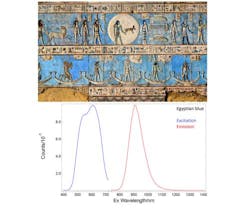Edinburgh Instruments’ spectrometers used to characterize Egyptian blue pigment

The applications team at Edinburgh Instruments (Livingston, Scotland) and Gianluca Accorsi, a Research Fellow at CNR Nanotec (Lecce, Italy) worked on the photophysical properties of Egyptian blue pigment using fluorescence spectrometers from Edinburgh Instruments.
Interest in noninvasive investigations for the study and identification of painting materials has greatly increased during the past two decades. The nature of museum objects is such that sampling is always kept to a minimum; thus, a spectroscopic approach is ideal for this purpose.
An ancient pigment, cuprorivaite (CaCuSi4O10), otherwise called Egyptian blue, has been photophysically investigated. The investigation includes qualitative information such as emission and excitation spectra, as well as quantitative info—that is, the photoluminescence quantum yields (PLQYs) that have been obtained in the near-infrared (NIR) region. The pigment proved to be a strong NIR emitter, with the highest known quantum efficiency for a molecule-level chromophore.
Excitation and emission spectra were measured using an FLS980 fluorescence spectrometer equipped with a 450 W xenon lamp and double excitation and emission monochromators. Egyptian blue showed a strong quantum yield of 10.5% with a peak at 920 nm.
Source: Edinburgh Instruments
About the Author
John Wallace
Senior Technical Editor (1998-2022)
John Wallace was with Laser Focus World for nearly 25 years, retiring in late June 2022. He obtained a bachelor's degree in mechanical engineering and physics at Rutgers University and a master's in optical engineering at the University of Rochester. Before becoming an editor, John worked as an engineer at RCA, Exxon, Eastman Kodak, and GCA Corporation.
